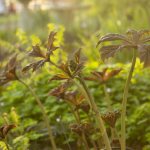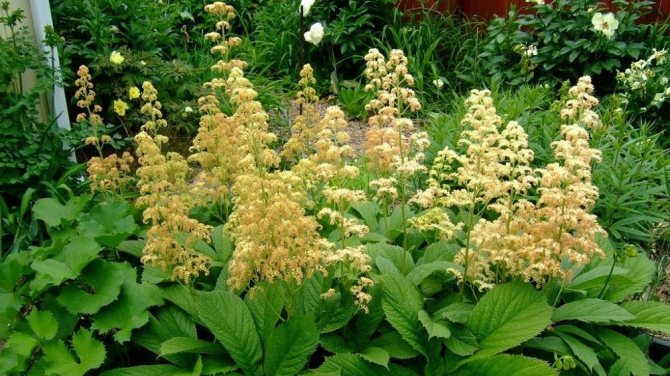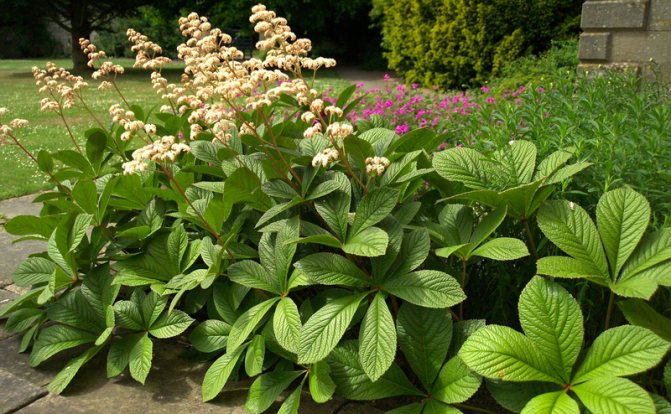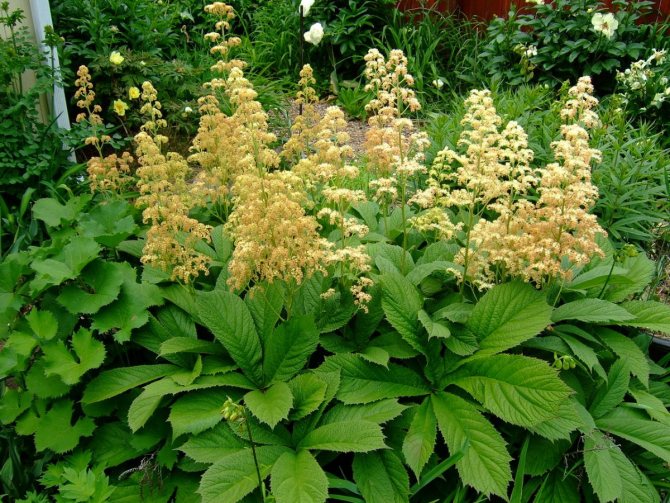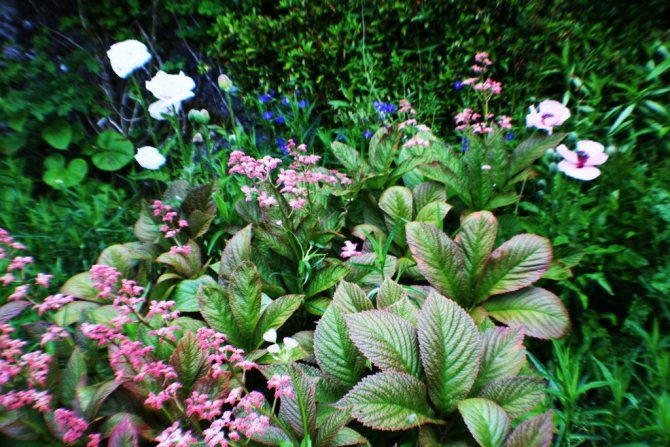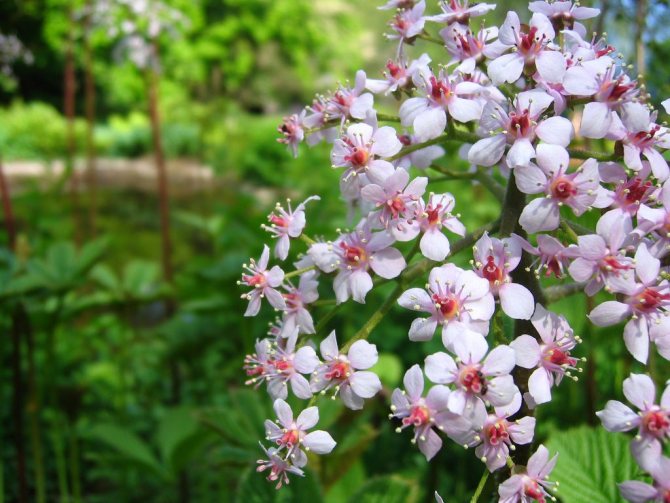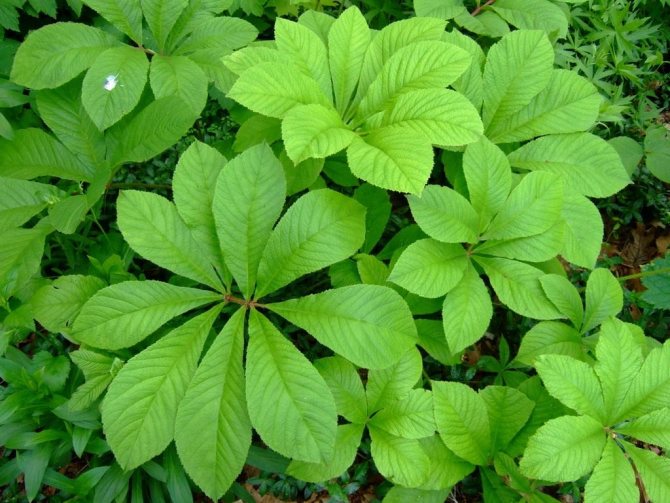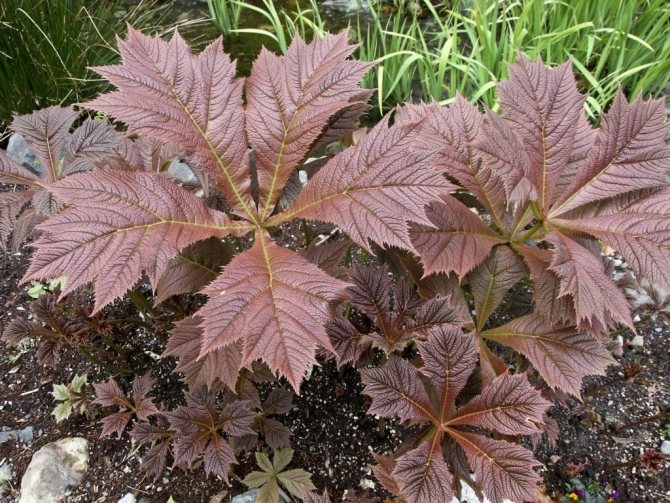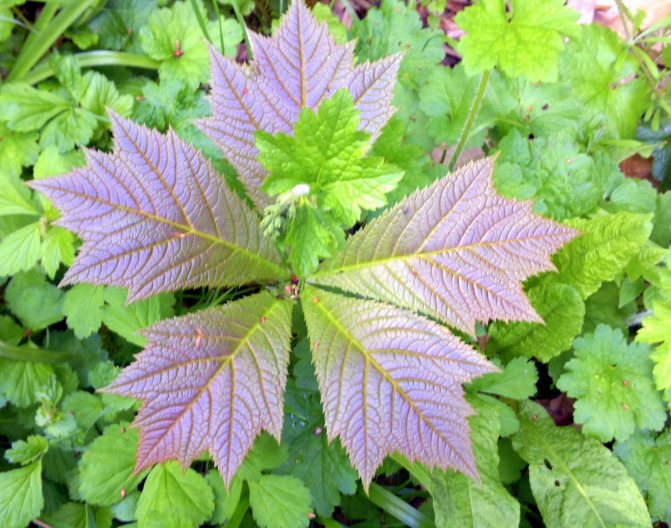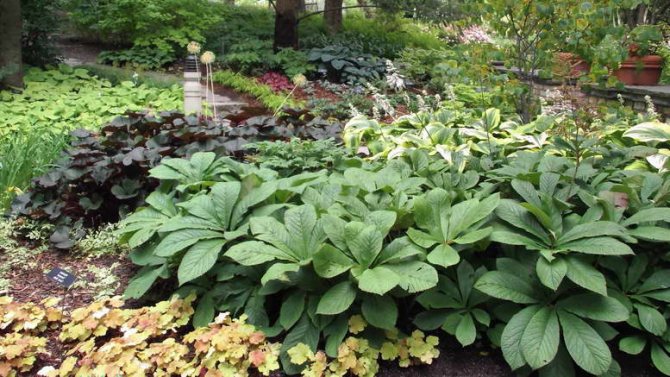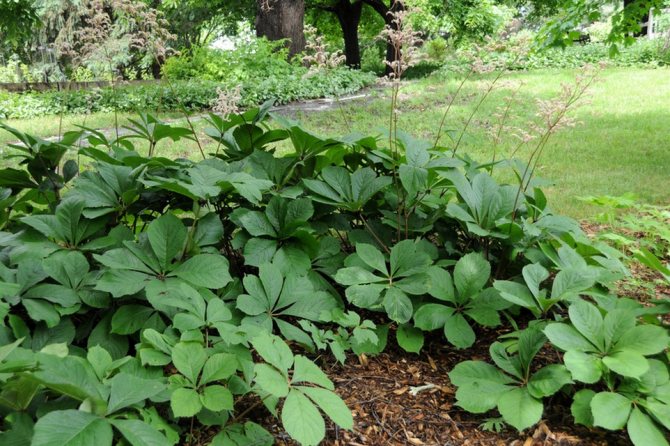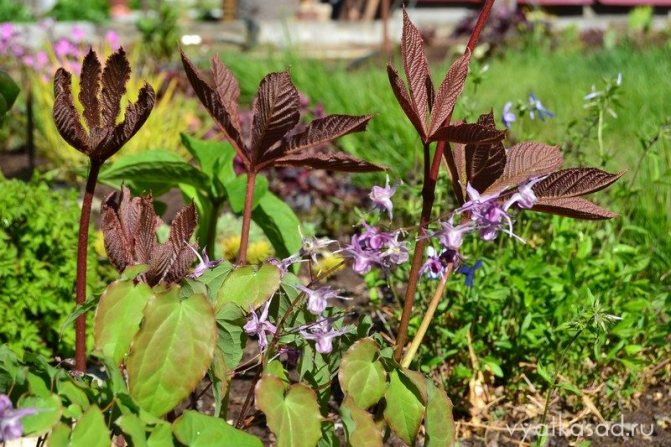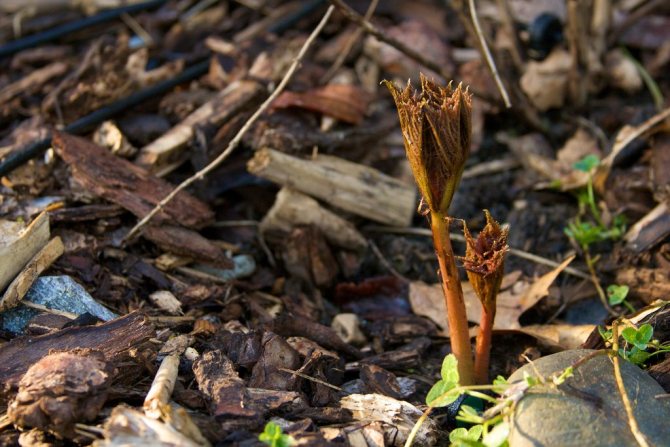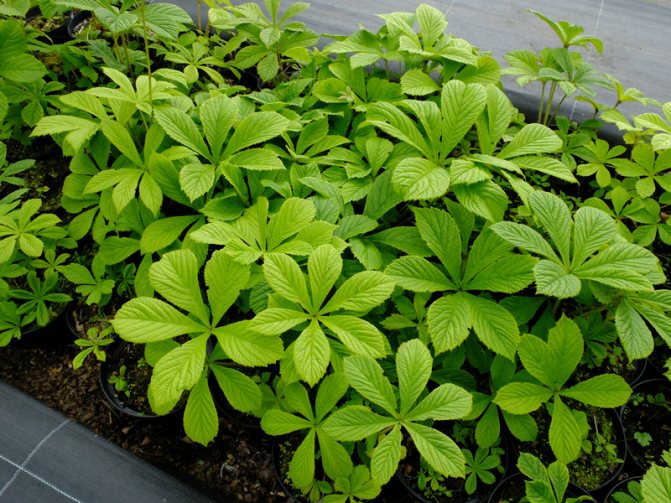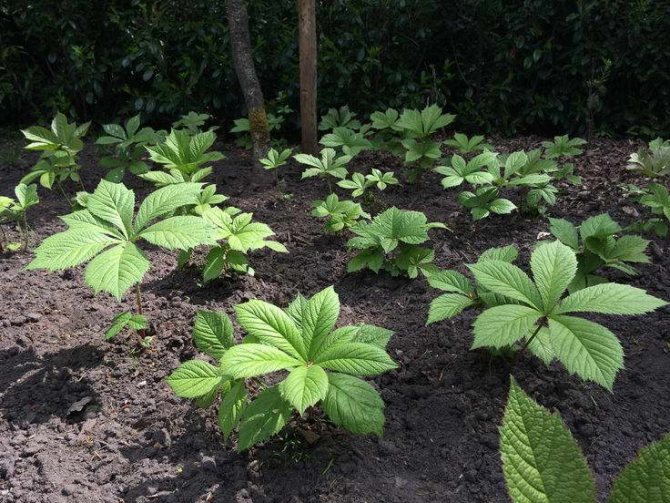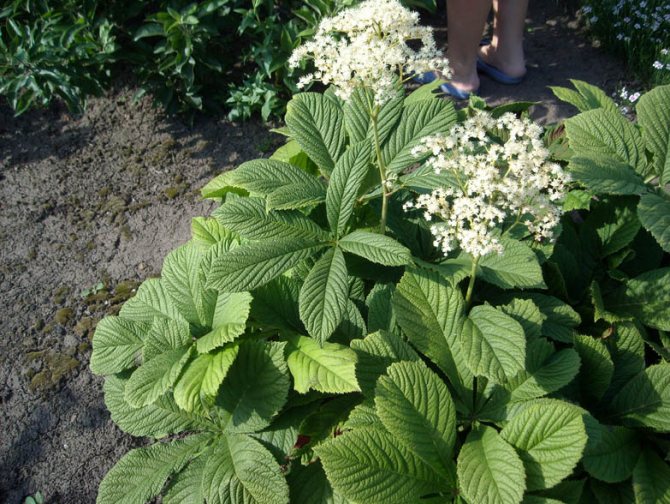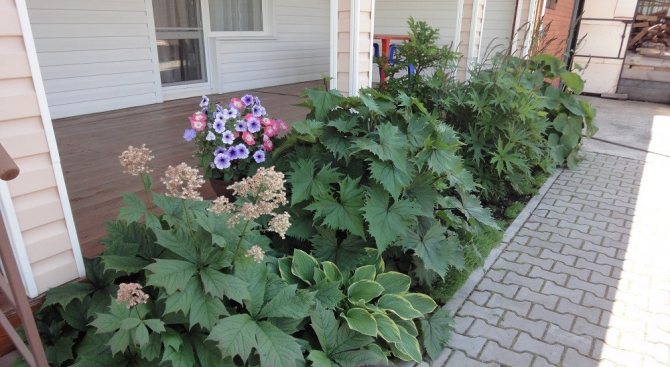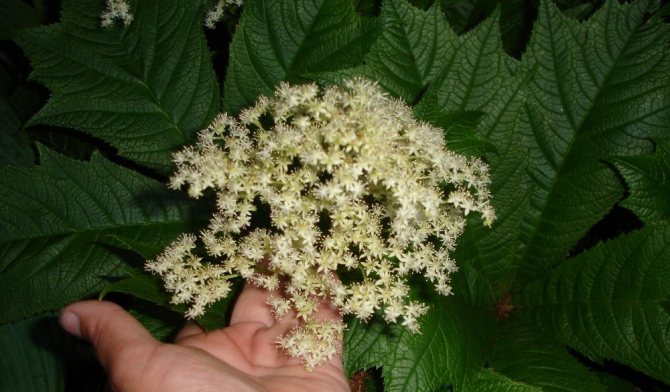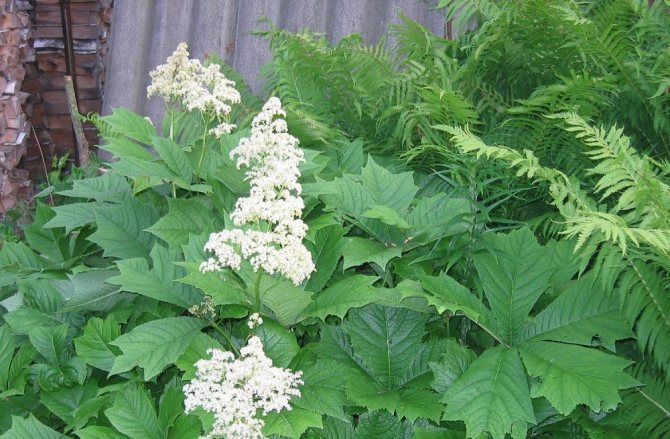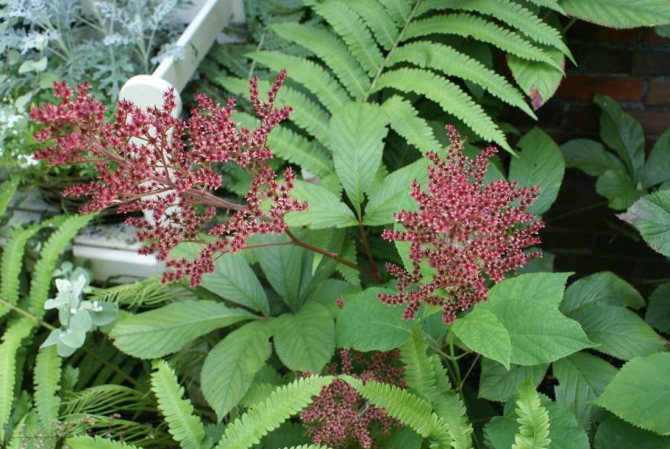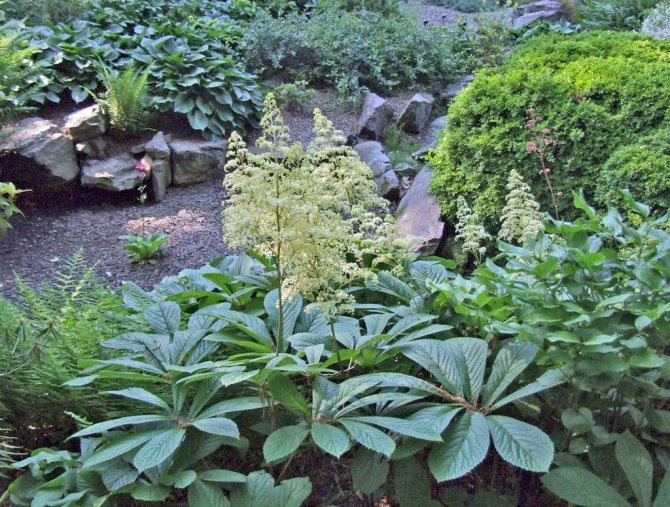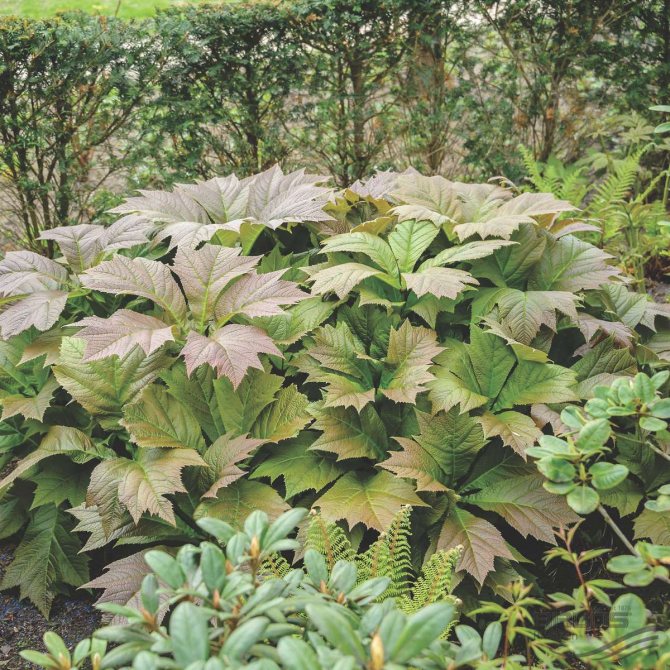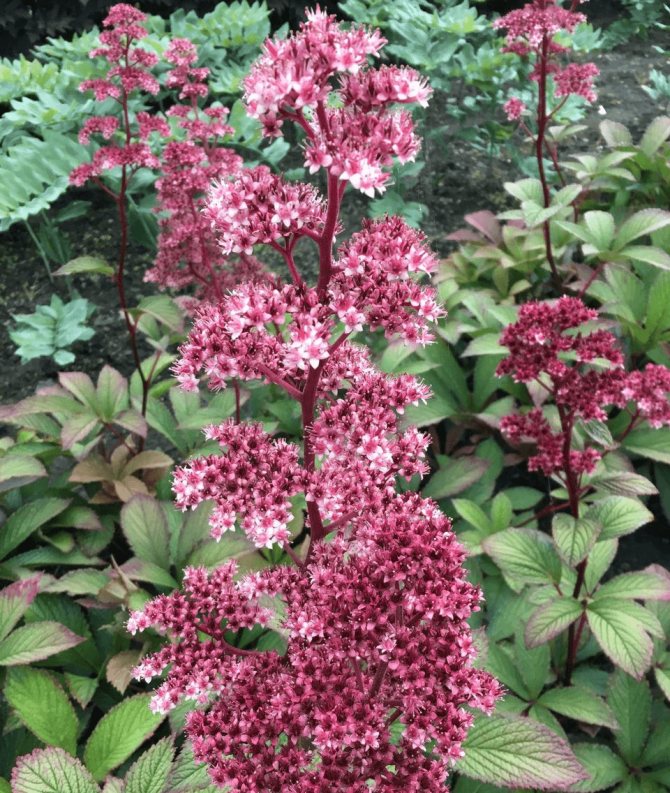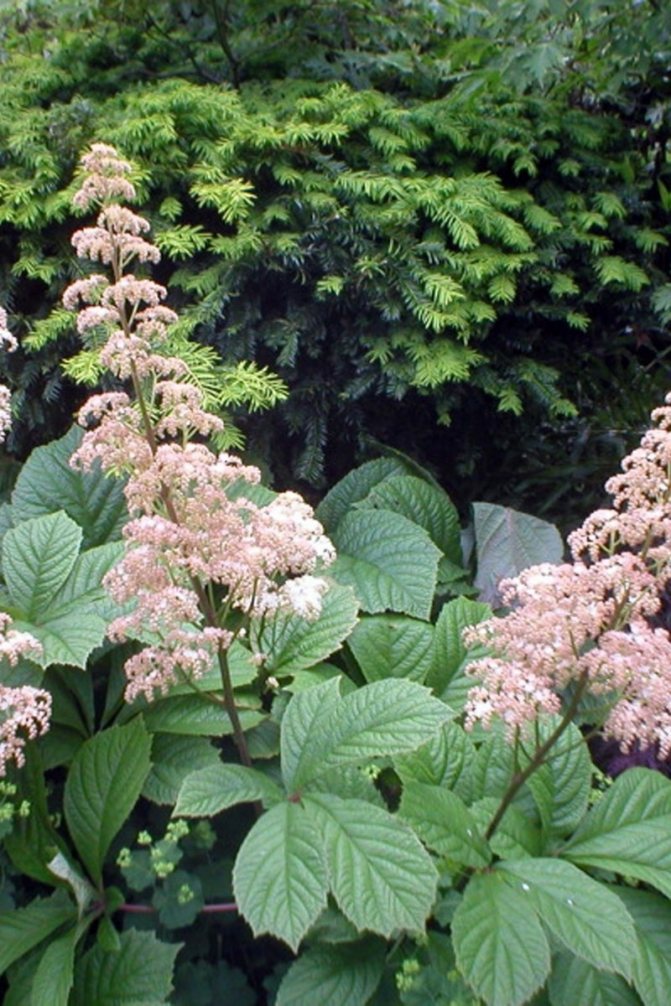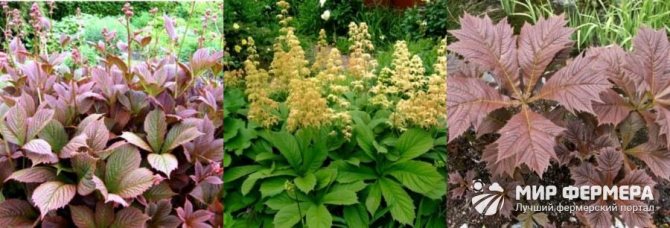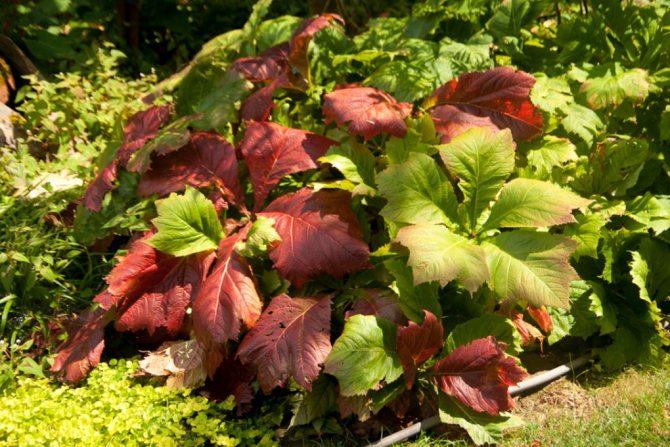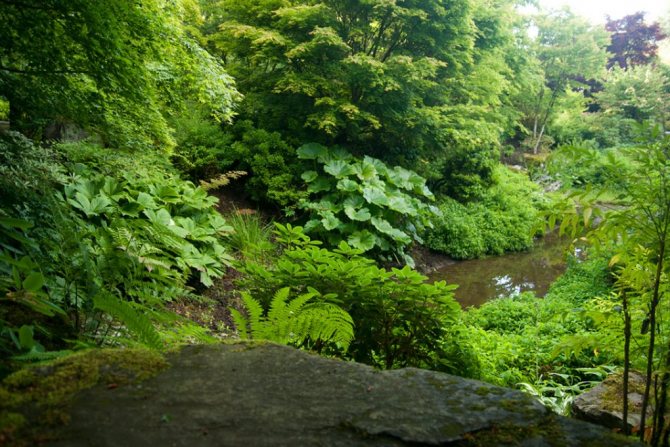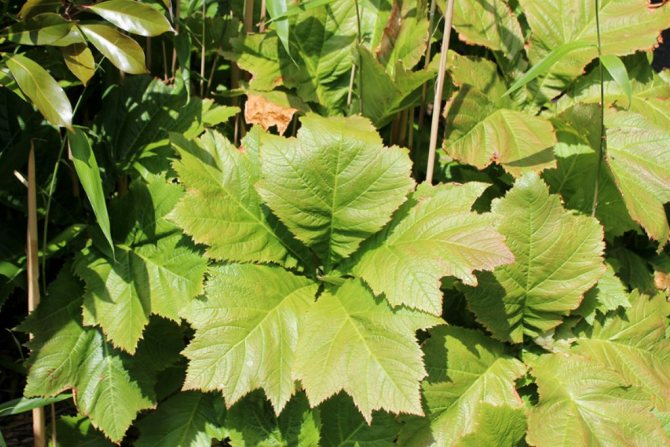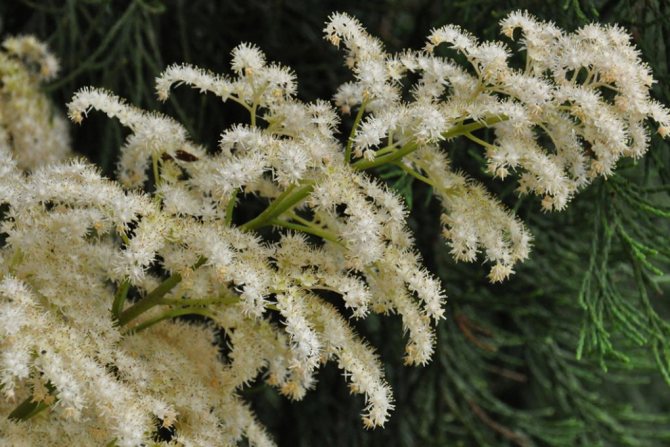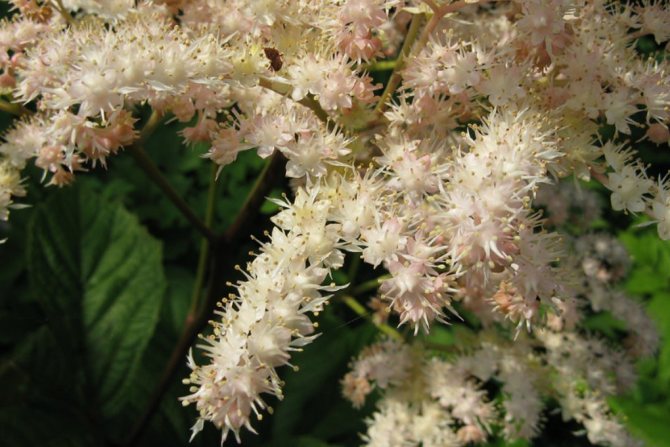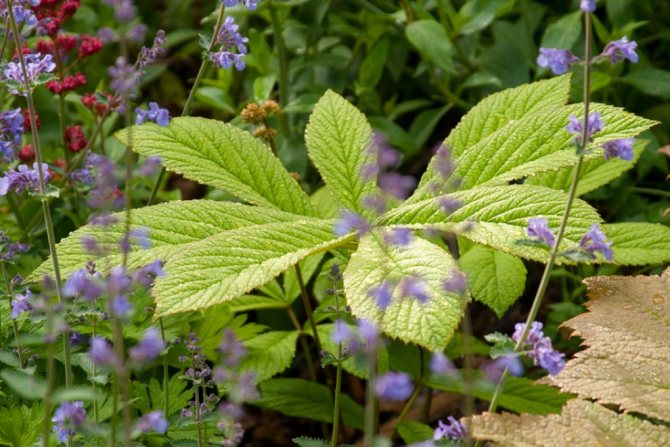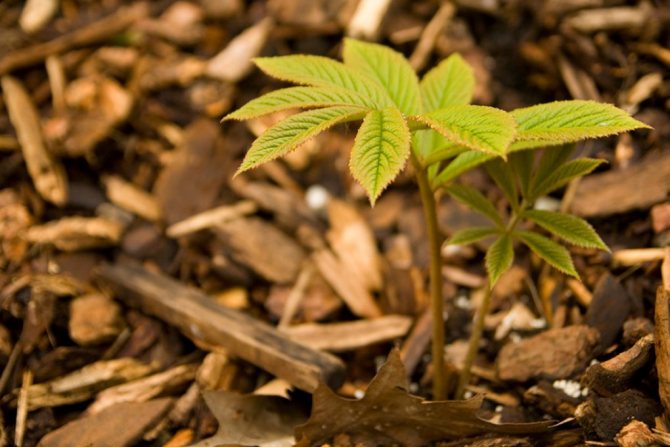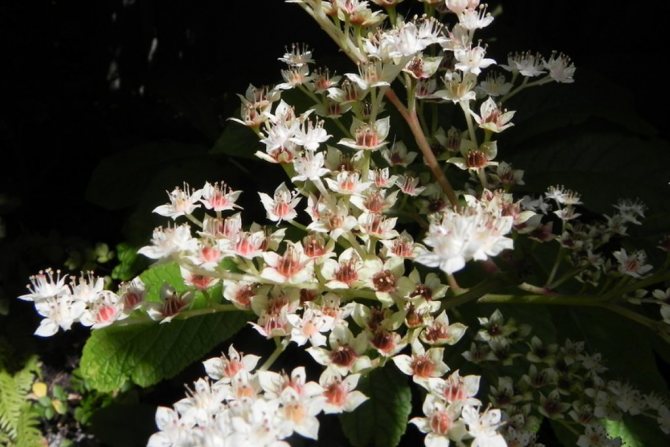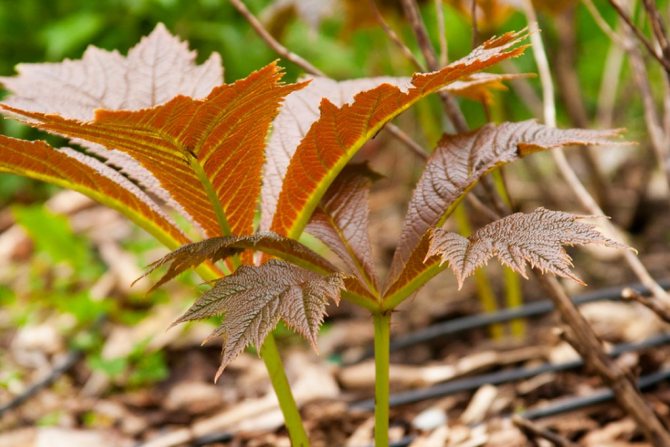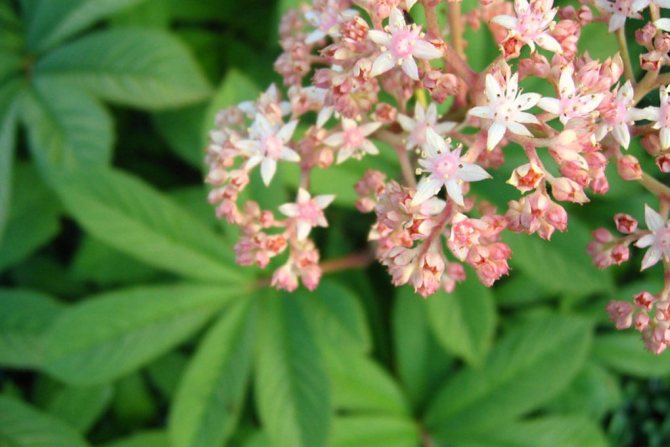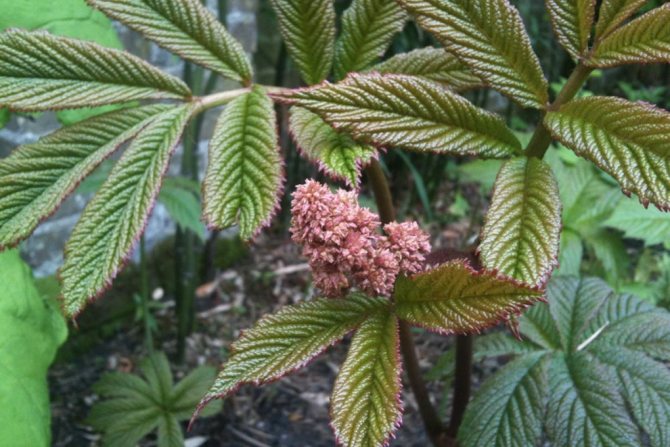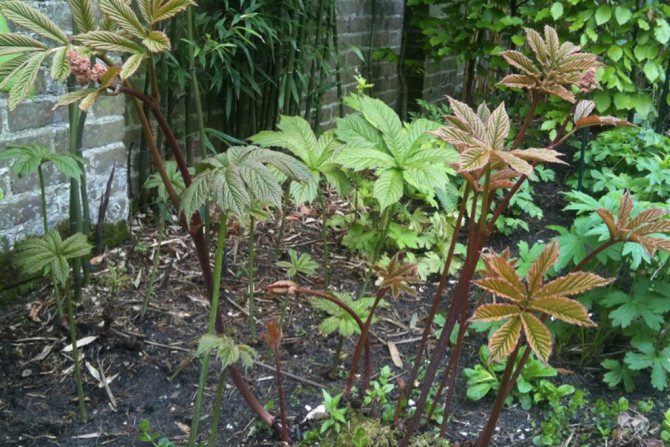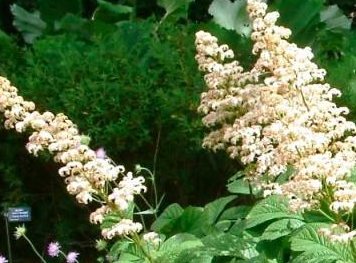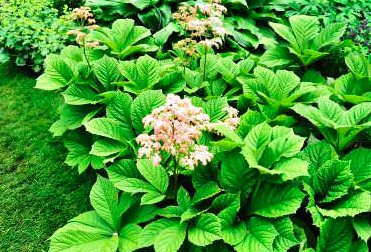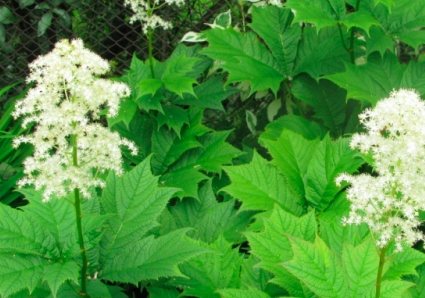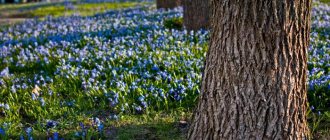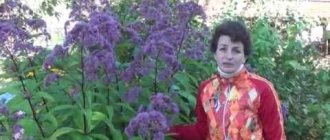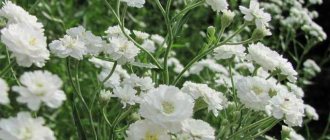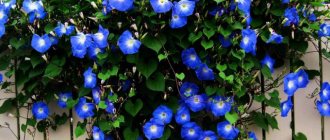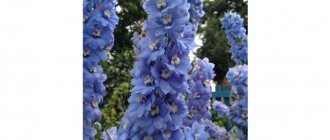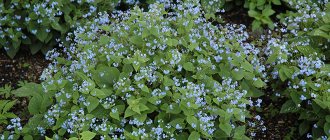Rogersia is a beautiful perennial with large carved leaves. It belongs to the Saxifrag family. His homeland is the vastness of Japan, China, Korea. Rogers grows mainly along the coast of rivers and fresh water bodies, as well as on lawns of moist forests, where the sun's rays fall only in the morning or at sunset. It is used to decorate a shady garden, because the plant is actively developing even in deep shade. When the flowering season begins, tall inflorescences bloom above the foliage, they complement the exquisite crown well.
Growing Rogers in the garden
The beauty is unpretentious, which is an indisputable advantage of the plant. Prefers partial shade, but if the soil is very damp, it is better to plant Rogers in sunny areas. The soil is preferable rich in organic matter, rather loose - air and moisture permeable, with a slightly acidic reaction.
It is better to “dilute” heavy loams with sand and loose organic matter, so that the exotic beauty will show its decorative effect to the fullest. It is better not to plant Rogersia where melt water can collect in winter with alternating frosts and thaws - the plant may die under such conditions.
It is also advisable to protect Rogers from strong winds, the plant loves places surrounded by a solid wall of stronger plants. Spring frosts can freeze the young leaves of Rogers, so if you want to protect it, keep an eye on the weather forecast, and in freezing conditions, you can light a smoldering fire next to the plants to protect them.
Rogersia has a strong creeping rhizome, due to which the perennial gradually grows, conquering ever large areas.
How to plant Rogers
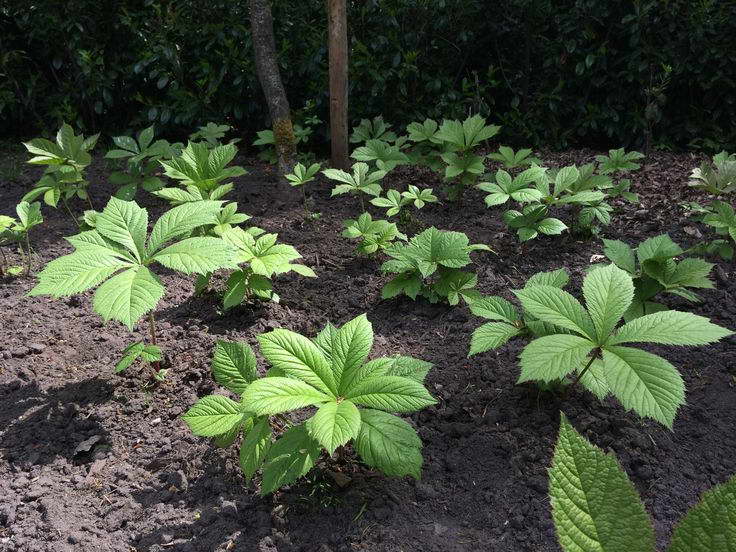
Planting Rogers in open ground photo
Before planting, you need to prepare the ground well, because the Rogers will grow in one place for many years. It is better to add more rotted compost or humus at the rate of 1 part of organic matter for two parts of garden soil. The hole is prepared in advance, taking into account the size of the rhizome of our seedling. It should be remembered that the perennial root is deepened by about 4-6 cm from the surface of the earth.
How comfortable the Rogers will feel in future years depends on the correct fit and choice of location. If everything is done correctly, the perennial will not need your attention for decades!
So remember:
- You need to choose a light partial shade, without the hot midday rays of the sun.
- Do not overburden the rhizome; on average, there should be a layer of soil about 5 cm above it.
- Take care of the good structure and nutritional value of the soil. Nutritious, light, humus-rich soil is the best environment for growing an exotic plant.
- Leave enough space for the development of the plant: after 2-3 years, the Rogers reaches its maximum size, the bush will be 60-100 cm in diameter, and up to 1.5 meters in height. Therefore, do not embarrass the beauty, plant it at a distance of 0.6-1.2 m from the nearest tall plants.
Why doesn't Rogersia bloom and grow?
Remember that by over-deepening the roots, choosing the wrong planting site or poor heavy soil, you may not wait for the growth and flowering of the bush, which will stop in development and will "sit still".
Choosing a landing site
The most important thing for Rogers is the absence of burning sunlight on the leaves. The plant is comfortable under the shade of trees, near buildings and fences.High humidity is also important to the bushes, ideally if there is a reservoir nearby. Drafts are also not to your liking.
Soils need nutritious and water-absorbing, but without prolonged stagnation of water. Therefore, clayey will need to be drained by adding crushed stone, sand or gravel. Poor sandstones are straightened by the introduction of humus, peat and clay.
Before planting the seedling, a layer of rubble is poured into the hole for drainage, then good fertile soil along with sand and rotted manure. Add 30 g of superphosphate or other mineral fertilizer to a bucket of the mixture. The bush, after being placed in the hole, is spilled abundantly with water, and the soil is mulched with peat or humus.
Rogers' transplant and vegetative propagation
Dividing the bush
It is very simple to plant a Rogersia: the rhizome should be divided into several parts with growth buds on each division in an amount of at least two or three. New bushes are also planted shallowly, up to 5-6 cm in depth, at a distance of 0.6-1 m from each other. It is better to replant in early spring or autumn, before the onset of frost, so that the plants have time to take root before wintering.
Propagation by cuttings
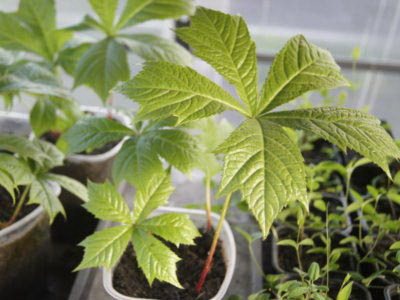

Rogersia cuttings
In the second half of summer, Rogersia can be propagated by leaves separated from a part of the horse, or "heel". Leafy cuttings are planted in seedling cups with loose soil and carefully looked after, providing regular watering and good lighting (light partial shade in the garden or eastern windows in the house is suitable).
When the cuttings release young shoots, this is a signal that the plants have taken root. In September-October, it will be possible to plant the resulting planting material in a permanent place, not forgetting to insulate for the winter. Cover the young rogers well with a thick layer of fallen leaves and press down with boards so that the shelter is blown up by the wind. In the next season, young bushes will actively grow.
Reproduction
Rogers can be propagated by seeds or vegetatively.
Seed reproduction is considered the most time consuming, as it requires lengthy preparation. Seeds are sown in the fall, immediately after harvesting to a depth of 1-2 cm. Boxes with fertile and light soil after sowing are left outside under a canopy from the rain. Cold stratification occurs within 2-3 weeks. After that, the crops are transferred to a warmer place (+ 11 ... + 15 ° C). Seedlings will appear in a few weeks. When the growth of the seedlings reaches 10 cm, they should be cut into separate pots or disposable cups. In May, the seedlings are transferred to the street, but they are transplanted into the open ground only in September. Flowering is expected only 3-4 years after transplantation.
Division of the bush. As the rogersia bush grows, it must be divided. This is at the same time a way of rejuvenation and reproduction. The procedure is carried out in the spring and the cuttings are immediately planted in the open ground. Division can be carried out in the fall, but then the roots are left in containers with soil for the winter. The bush should be completely dug up and freed from the earthen coma. The root is cut so that each site has at least one growth point. So that the rhizome does not dry out, it is immediately planted in the prepared soil.
Cuttings. A leaf with a petiole and a "heel" is able to take root. This breeding method is used in the summer. After cutting, the cuttings are treated with root roots and planted in containers with moist, light soil. Only well-rooted plants are planted in open ground. When transplanting, an earthen lump should be preserved.
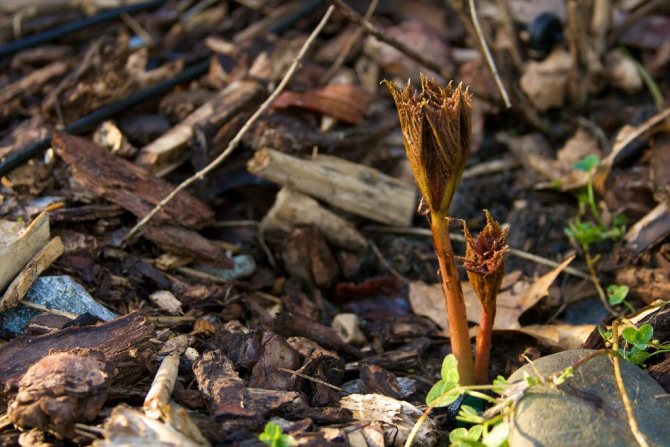

Growing Rogers from seeds
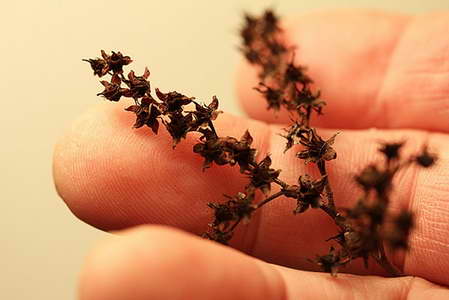

Growing Rogers from seeds photo
Planting Rogers with seeds is an exercise for the patient. If you grow a single variety, there will be no problems with cross-pollination, and it is quite possible to collect seeds from the most beautiful bush in order to sow them for seedlings. Remember that seed germination is poor and seedlings develop extremely slowly. Therefore, we stock up on patience and simply give the plants our care.We begin to sow for seedlings at the end of February, after holding the seeds in the refrigerator in a damp cloth and a bag for about two weeks.
Seedling rogers from seeds photo
- The seeds are small enough, they can be sown simply on the surface of the nutritious loose soil and lightly pressed with the palm of your hand.
- Water from a spray bottle, close the container with a transparent lid or a plastic bag, leave it on the window until shoots appear.
- We ventilate regularly, check the humidity. It should be remembered that moisture stagnation is unacceptable. Drainage holes in the seed container are required!
- When shoots appear, remove the film, water it as usual.
- When the first 2-3 true leaves appear, we dive the seedlings into separate cups.
- We take care of the seedlings until warm weather is established, when at night it will be + 15 ° С, then it will be possible to plant them on a flower bed.
Before planting, be sure to harden, taking out young bushes in a shady place in the garden for the whole day.
Pest and disease control
Rogers' foliage contains natural antiseptics, so the plant is practically not affected by diseases. But if the soil is waterlogged, the roots may suffer from gray rot. If this happens, watering must be reduced, the affected shoots must be removed, and the bush must be treated with an antifungal fungicide.
Damp soil can also provoke the appearance of snails and slugs on Rogers. This is evidenced by the damaged leaves of the plant.
It is recommended to fight pests by mechanical means or using chemicals. An effective preparation is Thunderstorm in granules that crumble around the bush.
It is also possible to collect slugs or set traps for them. You can put a damp board or a wet piece of slate next to the bush. At night, snails and slugs will gather under them, and in the morning they can be destroyed.
Outdoor care for Rogers
Exotic Rogers sets just a few conditions for the gardener. She needs soil mulching: this way the plant does not experience stress from overheating the soil in the heat. In addition, moisture is retained and the ground remains loose and breathable. During the period of active growth and flowering, do not forget to regularly water the Rogers bushes, however, do not flood until puddles form. And after flowering, at the end of the growing season, the aboveground part is cut off with a pruner and removed into a compost heap or burned.
Preparing for winter
Rogersia is frost-hardy and easily tolerates winters with frosts down to -25 ° C. However, covering it will still not be superfluous to help endure the stresses in the absence of snow cover. If the frost in your area is stronger, carefully cover the plant with fallen leaves, straw, cut grass, and cover the top with agrofibre or other insulating material. In the spring, the plants are freed so that young seedlings do not spill out.
Care
Rogersia can be watered straight from a hose with cold water, which sets it apart from other garden plants.
In hot summers, watering may be required daily, including sprinkling. At the end of August - September, water-charging irrigation is carried out, spending at least 40 liters of water per bush.
Once a month, Rogersia needs feeding, both root and leaf. Mineral fertilizers are suitable for flowers in a half dose. At the beginning of the growing season, you can feed it with infusion of mullein (1 kg per 10 l of water) or bird droppings (1 to 15).
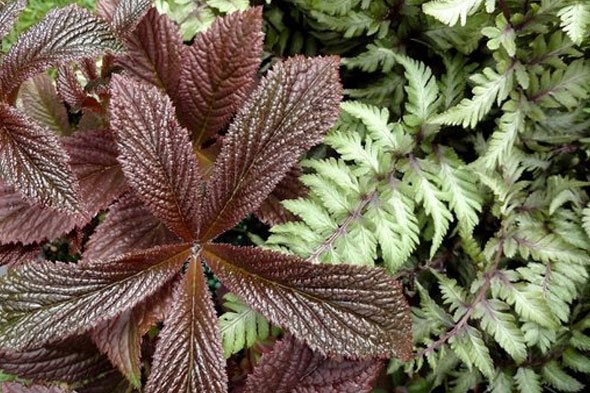

It is necessary to remove faded peduncles and dried leaves in time to preserve decorativeness.
Rogersia is resistant to diseases and pests. In rare years, it can suffer from an invasion of slugs.
For the winter, the aboveground part is cut off. The bush is covered with fallen leaves, shavings, peat or agrotex.
Rogersia in Landscaping
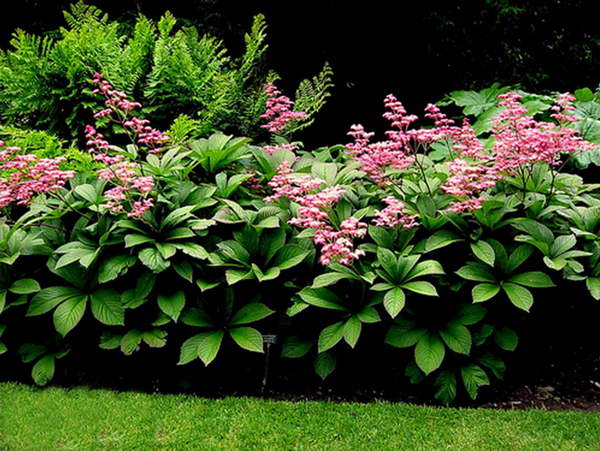

Rogers in garden design photo
Rogersia is attractive in mono plantings and group compositions. Often planted on the shores of artificial reservoirs, looks great in the shade of trees.
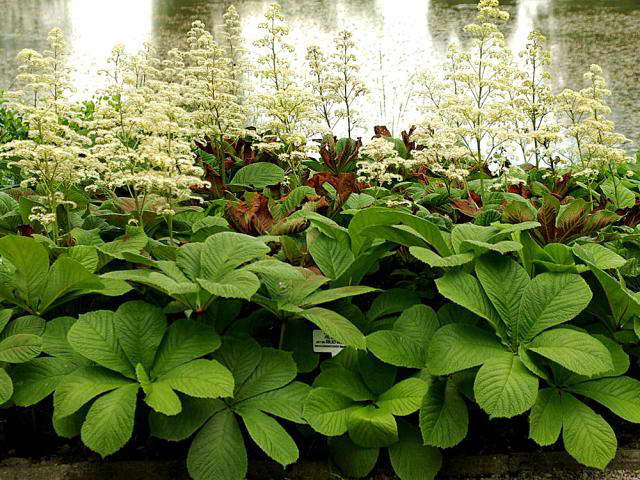

Rogersia horse-chestnut-leaved planting and care Photo by the reservoir
They combine Rogersia with hosts, ferns, bells, incense, mukdenia and other plants, here the main thing is to show your imagination.
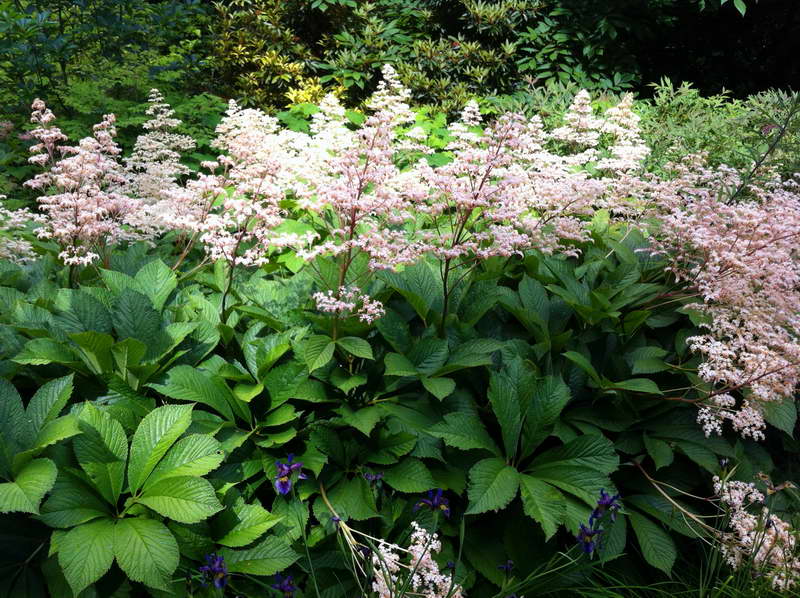

Monoplanting rogers in the shade of trees photo
By changing the color of the leaves from bright green to crimson, Rogersia brings a spectacular accent to any composition. This feature should be taken into account in order to make the garden design more harmonious.
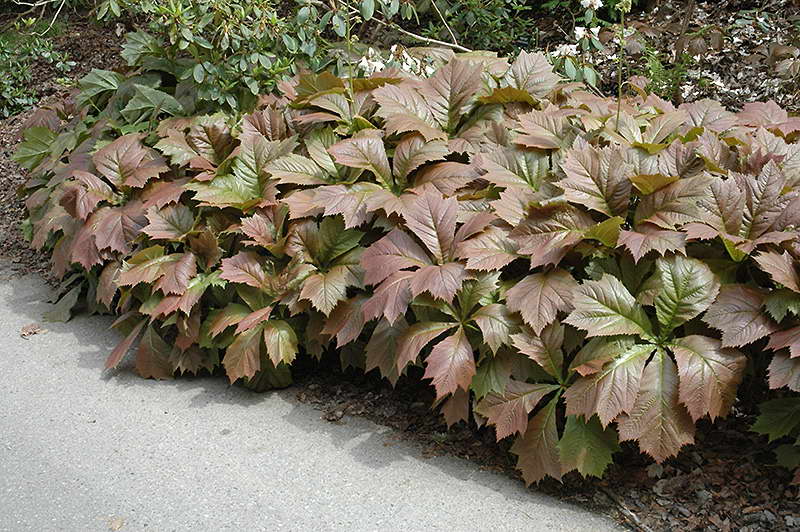

Rogersia flowers planting and care Photo in garden design
Rogersia is planted as curbs, low hedges. Looks beautiful in large-scale rocky gardens, rockeries.
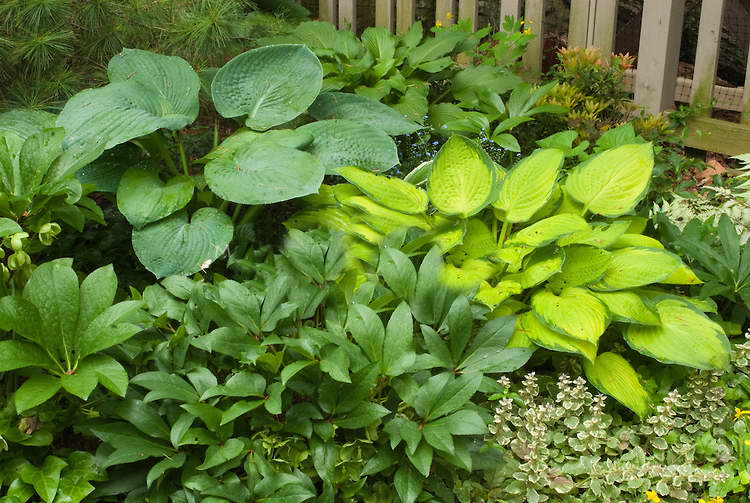

Rogersia, hosta, helleborus in a group planting photo
Rogersia looks spectacular next to ligularia, maple leaves, green ground covers. It turns out beautifully if you alternate spots from monoplants of plants of various kinds, you get a kind of alternating islets that delight the eye with their naturalness.
Top dressing of the bush
The first feeding of Rogers cones-chestnut leaves is introduced in the spring. For this, a nitrogen-containing organic fertilizer is used. The bush reacts well to the introduction of nutrients, blooms more abundantly and actively grows foliage. In the summer, it is root-fed with phosphorus-potassium fertilizer. It is important that copper, magnesium, zinc and sulfur are present in complex fertilizers for Rogers. When the plant fades, the inflorescences are removed so as not to spoil the decorative appearance. If desired, it can be transplanted to another place, but, being constantly on one site, it becomes more attractive every year and more and more pleases the eye of its owners.
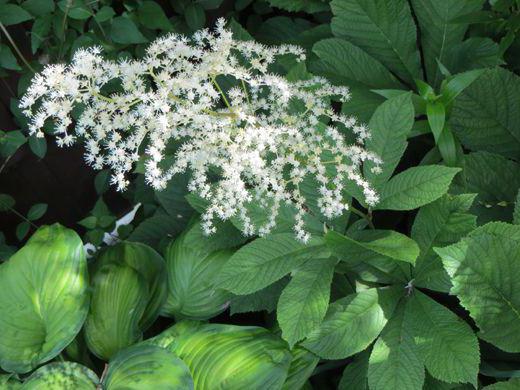

Varieties and types of Rogers Photo with the name
Rogersia horse chestnut Rodgersia aesculifolia
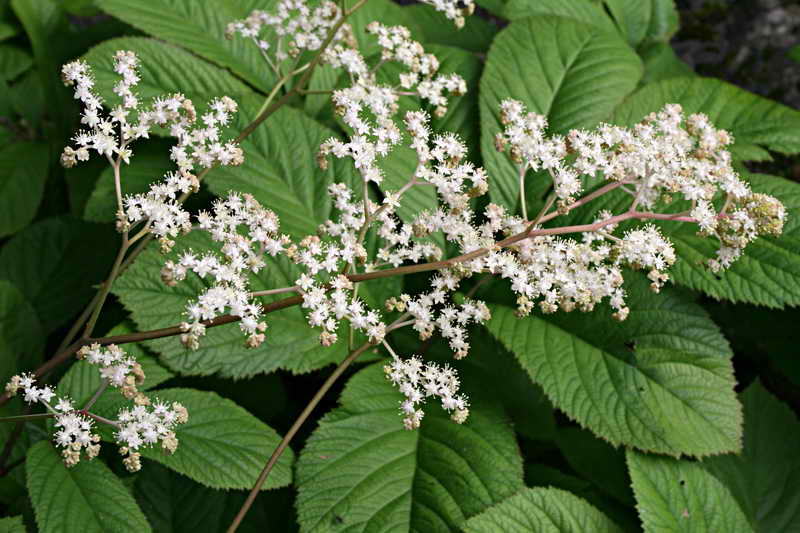

Rogersia horse-chestnut Rodgersia aesculifolia photo
Reaching a meter in height, the perennial has large seven-fingered leaves resembling chestnut, which is why it got its name. Flowers are often unremarkable (but there are flowering varieties as well), the plant is grown for the sake of a decorative carpet of luxurious leaves, which are painted in a scarlet-bronze shade in autumn.
Rogersia pinnate Rodgersia pinnata
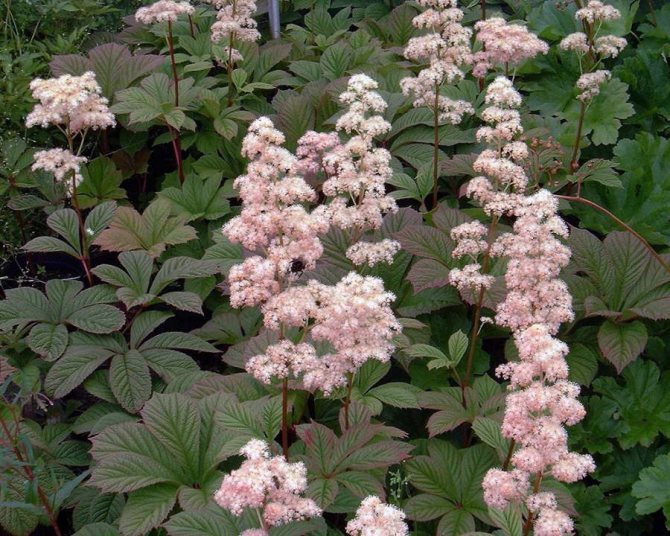

Rogersia pinnate variety Chocolate Wings Rodgersia pinnata ‘Chocolate Wings’ photo
The feathery Rogersia is beautiful with sharp toothed, slightly elongated leaves, especially varieties with a delicate pink-burgundy shade of leaves and flowers, for example, the Chocolate Wings variety.
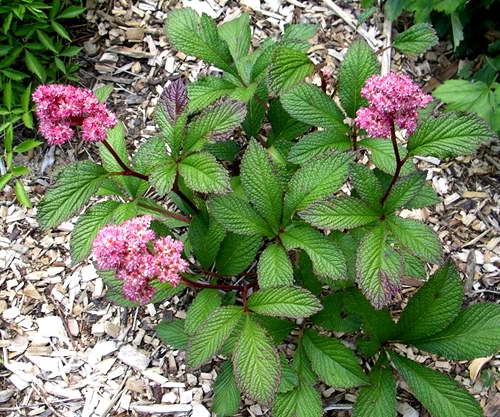

Rogersia feathery fireworks Rodgersia pinnata ‘Fireworks’ photo
The fireworks variety is notable for its compact pink inflorescences on dark-burgundy powerful peduncles.
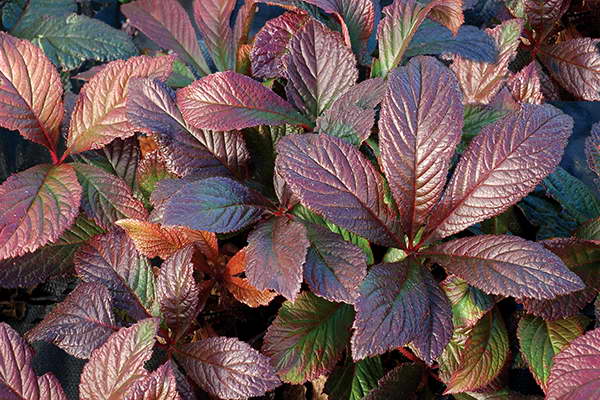

Rodgersia pinnata Bronze Peacock photo
The variety of bronzes picok fell in love with elegant leaves with a bronze tint, shimmering in the light in many shades.
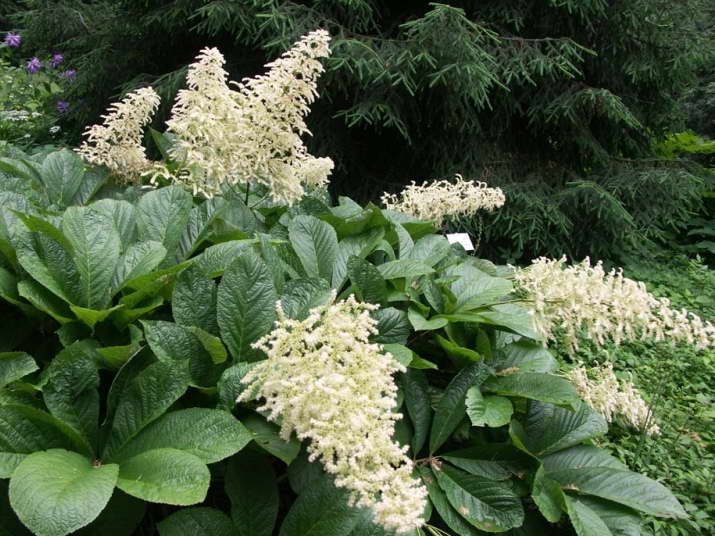

Rogersia feathery white elegans photo
The elegans variety with small inflorescences of milky white flowers is very attractive.
Rogersia podophyllum or stooliferous rodgersia podophylla
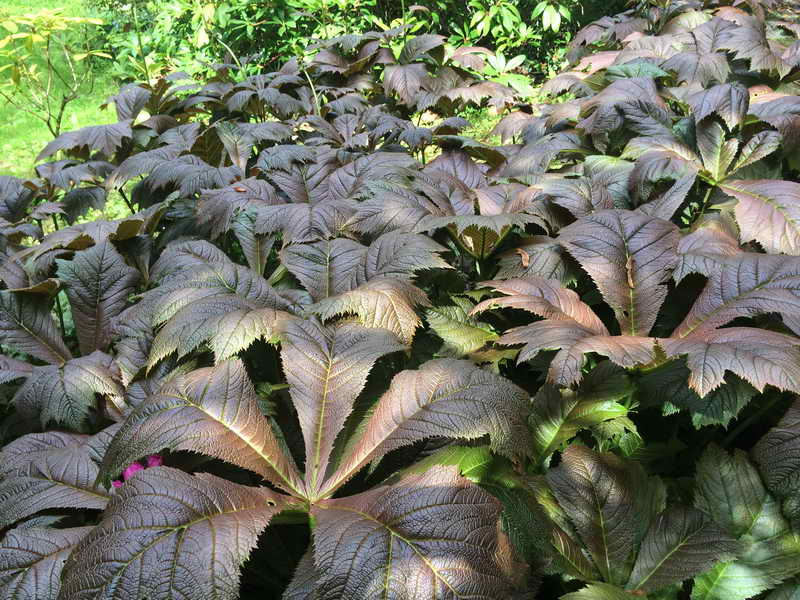

Rogersia podophyllum cultivar Brownlaub braunlaub rodgersia podophylla photo
Huge, luxurious five-piece palm-like leaves cover the earth with a fabulous carpet. For example, Braunlaub rodgersia podophylla with a bronze, burgundy hue is a great choice for decorating shady areas of the garden.
Description of the plant
Rogersia is a perennial herb with a taproot system. Over the years, horizontal branches with new growth buds also appear on the rhizome. The flower forms a spreading semi-shrub due to erect, branched shoots. The height of the growth, together with the inflorescences, reaches 1.2-1.5 m.
The main decoration of Rogers is its foliage. The diameter of the pinnate or palmate leaf plate can reach 50 cm. The leaves are located on long petioles. Smooth leaf plates of a bright green or reddish hue sometimes change color throughout the year.The shape of the rogersia leaf resembles chestnut.
Flowering begins in July and lasts a little less than a month. During this period, complex paniculate inflorescences, which consist of many small flowers, bloom over the dense greenery. The petals can be pink, white, beige or greenish. Flowers exude a delicate, pleasant aroma. After the flowers wither, the foliage starts growing with even greater activity.
As a result of pollination, miniature seeds in the form of stars are tied. At first they are covered with light green skin, but gradually turn red.
How to care for a plant
Rogersia is actively developing even in deep shade, besides, it blooms with fragrant flowers on tall inflorescences. But in order for this plant to become a real decoration of the garden, it must be properly looked after.
Soil care
Rogers rhizomes are very close to the surface, so the soil around it must be constantly inspected, often loosened throughout the season and weeds removed. Hilling saturates the ground with air, and in order to prevent the evaporation of excess moisture, after this procedure, the soil must be re-mulched. When caring for a plant, it is important to ensure that the roots are not exposed and do not dry out, and otherwise sprinkle them with humus or soil.
Top dressing
Organic and mineral feeding should be carried out not only in spring or autumn, but also during the growing season and flowering. These should be complex fertilizers, which include iron, sulfur, magnesium, copper, phosphorus and zinc.
Watering
It is necessary not to allow the soil to dry out, then the plant will bloom and have very beautiful leaves. Watering should be abundant and regular, but it is also necessary to carefully monitor that there is no stagnation of water - this leads to decay of the rhizome.
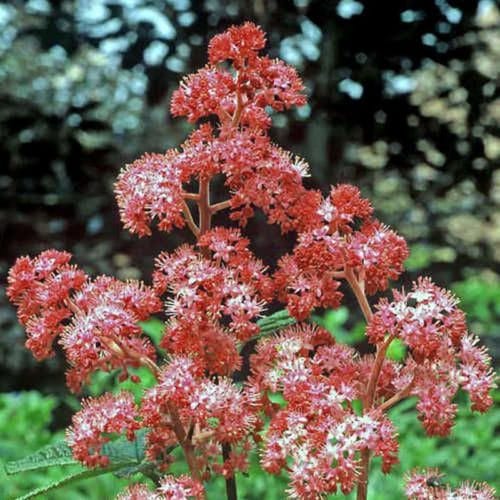

Since the homeland of Rogers is humid forests and places near water bodies, for its active growth and development, you need to recreate such conditions as much as possible on your site
Pruning
Leaves and flower stalks with seeds should be carefully trimmed as they dry, regardless of the season. Dried or damaged leaves are removed with a sharp knife or pruner, but the flower stalks are removed only if seed collection is not planned.
Transfer
If the place for planting Rogers is chosen correctly, then in one place it grows for about 10 years (usually 

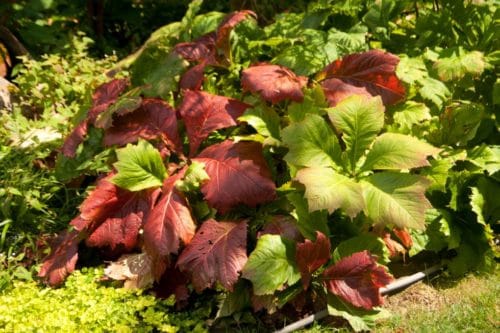

This is how the plant grows, if all the requirements are met, for proper care of it
Winter preparation and care
Rogersia generally tolerate winter well if properly prepared for wintering. To do this, you need to cut off almost all the leaves and shoots at the root and cover with a thick ball of dry leaves, peat sawdust or humus. But in the case of a winter with little snow, additional protection from severe frost is needed, then the Rogers is covered with a piece of non-woven polypropylene fabric, with a density of at least 40-60 g / m2
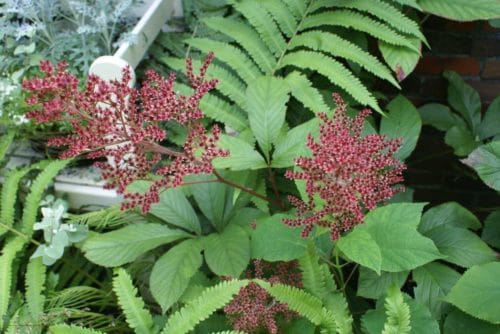

It is important to cover Rogers in early spring with a non-woven fabric to protect it from night frosts.
It is important not to cover the plant with a film so that the greenhouse effect does not arise - Rogers does not like this.
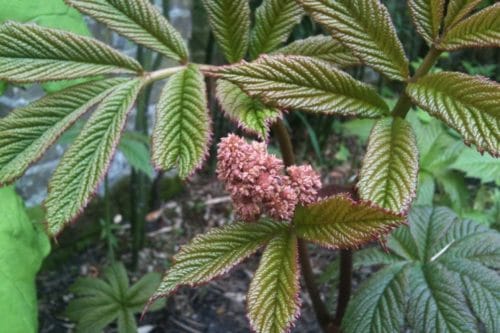

Non-woven fabric not only provides a good winter shelter, but also protects plants outdoors from bright sun and frost. It transmits air, light and heat well, protects from birds and insects
Mulching soil for Rogers
The soil for planting Rogersia must be rich in nitrogen. With a sufficient amount of this element, the leaves of the plant grow large, fleshy and very beautiful. To enrich soil mixtures with nitrogen, humus and soil taken from under leafy trees are added to them. In such a land there is leafy humus and not rotted foliage. When these components are mixed, a light, loose and aerated soil is obtained.Excess moisture will not stagnate in it and oxygen will be able to flow to the roots of the plant. In early spring, when Rogersia sprouts rise 5-10 cm above the ground, the soil at the foot of the bush is mulched. Mulch prevents moisture evaporation, weeds growth and, in some cases, fertilizes the bush itself.
Articles for gardeners and gardeners
How to fertilize the soil in spring?
Growing onions in a bag without land Growing roses from cuttings from a bouquet
How to fertilize an apple tree in spring?
Fertilizer requirements
For dynamic growth and lush blooming, Rogersia needs to be fertilized with magnesium, nitrogen, phosphorus, copper and zinc. Top dressing should be carried out throughout the growing season. Also, nutrients should be added at regular intervals.
When adding fertilizers, you must strictly adhere to the instructions and the proportions prescribed in it. An excess of solution can burn the delicate roots.
After hibernation, the plant must replenish all the necessary trace elements, for this in the spring it is necessary to nitrate the soil. This can be done with chicken manure, mullein tincture, or ammonium nitrate. The first 2 options for feeding should be fermented for two weeks before use in order to avoid root burns.
Preparing for winter
So that, in the harsh snowless winters of Rogers, the buds of renewal are not damaged, in the fall, after cutting the leaves, the plant must be sprinkled with a small layer of compost or fallen tree leaves. Less susceptible to frost are varieties that germinate late, such as ‘Die Schone’, ‘Die Stolze’, ‘Die Anmutige’, ‘Spitzentanzerin’ or ‘White Feathers’. Returning spring frosts, which damage the leaves of the plant and the rudiments of inflorescences, can also be harmful. To prevent this from happening, in the spring on the eve of a cold snap, the bushes need to be covered, for example, with non-woven material.
So that, in the harsh snowless winters of Rogers, the buds of renewal are not damaged, in the fall, after cutting the leaves, the plant must be sprinkled with a small layer of compost or fallen tree leaves
Where can one buy?
| Variety | address | price |
| Horse chestnut rogers | Villa-planta (garden center and nursery), St. Petersburg | 290 rubles |
| Online store | 300 rubles | |
| Online store "Delenka" | 310 rubles | |
| "Chocolite Wings" in seedlings | Moscow Alley Verkhnyaya, 1 | 899 rubles |
Foliage effect
Different types of rogers differ from each other in shape, color and structure of the leaves.
1. Have Rogers Elderberry (Rodgersia sambucifolia) they are finger-dissected, resembling elderberry leaves. Hence the name of the species. Rogersia elder (Rodgersia sambucifolia)
2. Rogers feathery (Rodgersia pinnata) differs from other species in more elongated leaves. Rogersia pinnata (Rodgersia pinnata)
3. Rogers horse chestnut (Rodgersia aesculofolia) lives up to its name, as its leaves are similar to those of a horse chestnut.
Rogersia horse-chestnut (Rodgersia aesculofolia)
4. Rogersia centipede (Rodgersia podophylla) is the most different from other species: its leaves are serrated along the edge, and at the ends they are, as it were, cut off. Rogersia podophylla (Rodgersia podophylla)
5. Have Rogers Nepalese (Rodgersia nepalensis) the leaves on the leaf petiole are "planted" at a great distance from each other. Rogersia nepalensis
Rogersia flowers also look very cute and have a pleasant aroma. In mid-summer, white or pink-red fluffy paniculate inflorescences on long peduncles sway gracefully in the wind. Rogersia usually blooms for 20-30 days.
The most popular types are R. horse chestnut (Rodgersia aesculifolia), R. Henrici (Rodgersia henricii) and R. feathery (Rodgersia pinnata).
- Bush height rogers horse chestnut - 80-100 cm, its peduncles with white or slightly pinkish inflorescences reach 1.2 m. Young leaves are green, with a noticeable bronze tint, resemble a chestnut leaf in shape.
- Rogersia Henrici just below, in summer, its leaves are the brightest green of all Rogers. The shade of the inflorescences - from cream to pale pink, depending on the composition of the soil and weather. This Rogersia proved to be the most sun-resistant.
- Rogers feathery no more than 60 cm in height. The leaves are similar in structure to rowan leaves, the flowers are creamy with a white or pinkish tinge.
These, as well as other, lesser known, Rogers species can be used in both single and group plantings.Only in both cases, you need to immediately allocate more space for the plant, because it grows strongly. Rogers is also resistant to diseases and pests, so it won't give you much of a hassle. Only too intense sunlight, drought or return spring frosts can harm this plant.
1. Left: ‘Die Stolze’ Rogersia pinnate with beautiful coral-pink inflorescences blooms from mid-June to July. The bush reaches 120 cm in height. This variety is considered to be sun tolerant. On right: ‘Cherry Blush’ differs in large textured leaves, which turn bronze in spring and autumn. Inflorescences are pink. This variety is considered the most sun-resistant.
Left: 'Die Stolze' pinnate Rogers. Right: ‘Cherry Blush’
2. Young leaves of 'Rotlaub' attracted by color, at a "young" age has a reddish tint, later the leaves turn green. Creamy white inflorescences appear in May - June. The plant reaches 110 cm.
Rogers '' Rotlaub ''
3. Have a variety ‘Rothaut’ Rogers Elderberry dark red stems, beautiful leaves and showy light pink flowers that bloom in early June and last until July. Grows up to 140 cm.
Rogersia Elderberry 'Rothaut'
Play of colors: The reddish leaves of ‘Rotlaub’ Rogersia podophylla are in perfect harmony with hydrangea, ornamental onions and heuchera.
Play of colors: the reddish leaves of ‘Rotlaub’ Rogersia podophylla are in perfect harmony with hydrangea, ornamental onions and heuchera
Rogers coexist well with buzulniks, delphiniums, daylilies, badan, astilbe, volzhanka. Our heroine also can be a wonderful decoration for the banks of reservoirs, especially in combination with plants that are contrasting in the structure and texture of the leaf, for example, ostrich, sedges, airovid iris.
Watering mode
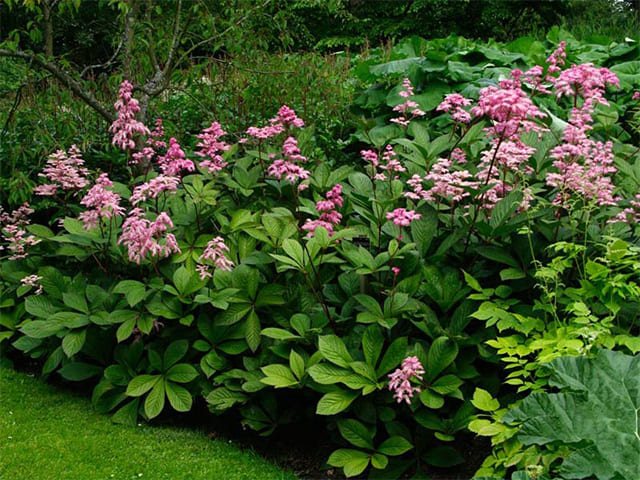

In the summer, the flower especially needs moisture. It must be carried out with cold water at least twice a week. The amount of water can vary depending on rainfall and the degree of aridity of the soil.
On the eve of the first cold weather, the flower needs to stock up on moisture: in the fall, before the plants shelter for winter, 3 buckets of water need to be poured under each bush. Abundant watering will ensure the emergence of new flower ovaries. Similarly, Rogersia is recommended to be watered in the spring, with the arrival of the first heat.
Meet your relatives!
The decorative-leaved beauties of the saxifrage family can also include such plants as darmera thyroid (Darmera peltata) and astilboides lamellar (Astilboides tabularis). The first reaches 1 m in height, and its peduncles are 50 cm, prefers wet areas and grows well right at the edge of the reservoir. Flowers bloom even before the leaves appear.
Darmera thyroid
Astilboides lamellar leaves are openwork, serrated at the edges. This plant reaches a height of 1 m and grows well in partial shade, on moist, nutrient-rich soil. White inflorescences, as well as thyroid darmera, rise above large leaves.
Astilboides lamellar
Photo: Mein schoner Garten magazine archive, Flora Press / Visions, StaudenaSrtnerei Gaissmaver, Annette Timmermann, MSG / 31 / A, Inhters / M. Staffler, Marion Nickig. Production: A. Doll / M. Lietzau.
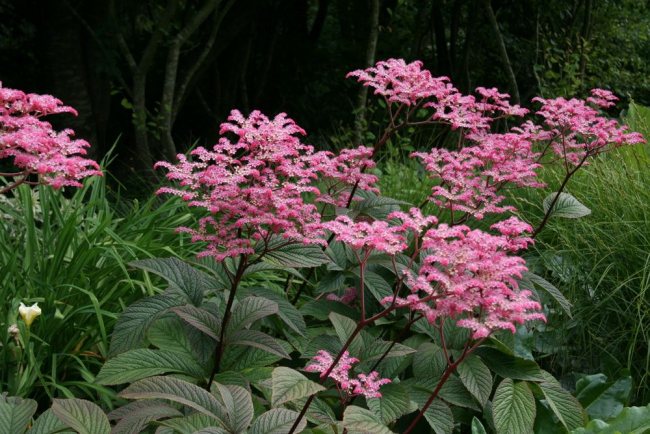

Perennial with pink flowers
Rogersia is a spectacular perennial with large carved leaves. It is related to the family of saxifrage flowers. Japan, China, Korea are considered its full-fledged and full-fledged homeland. Such a plant grows mainly on the banks of rivers, near fresh water bodies, on lawns. The culture is used to decorate the shady garden, because when the flowering season starts, tall inflorescences begin to bloom above the foliage, which ideally complement the crown.
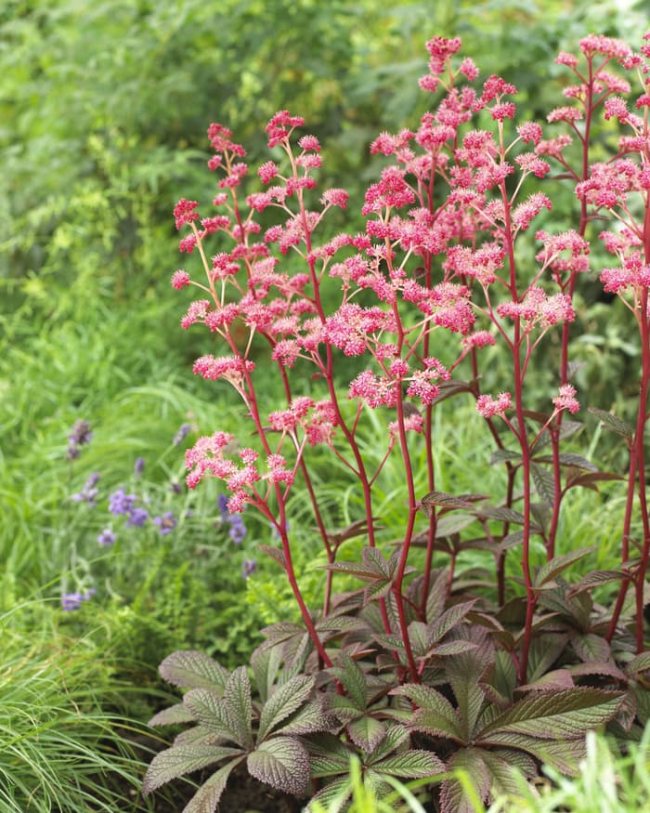

Beautiful perennial in the garden
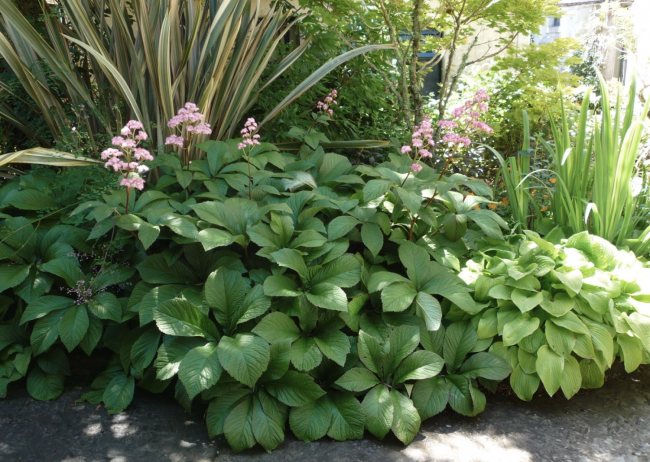

Blooming perennial in landscape design
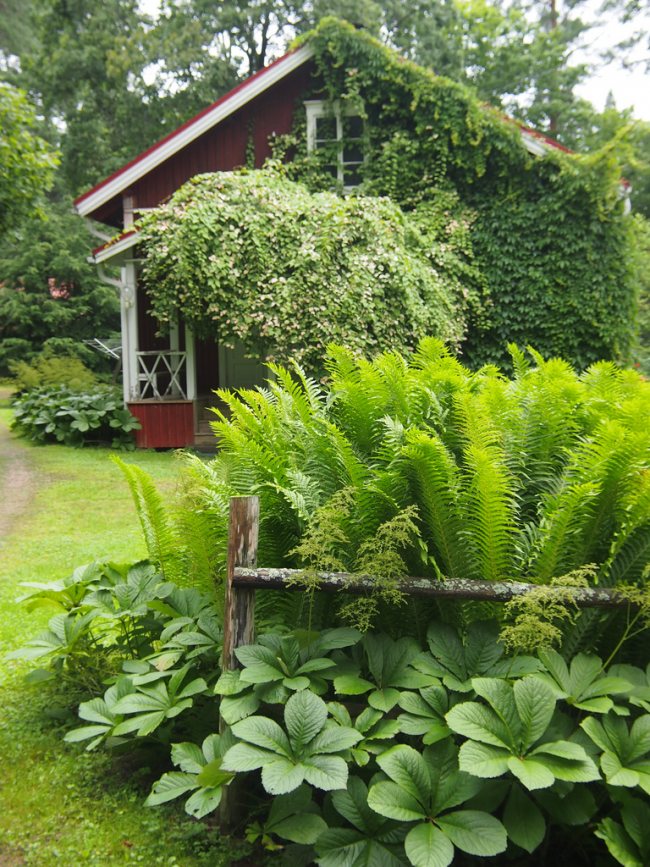

This plant goes well with fern
Picking
Usually Rogers, if the planting was correct, grows well for many years, and caring for it is simple and not burdensome. It does not require frequent transplantation, but if it is nevertheless required, do not be afraid - the Asian flower will easily transfer it.
It is categorically impossible to plant Rogersia in swampy lowlands, as this can provoke the appearance of root rot, which is deadly for absolutely all crops.
When transplanting, you need to dig a hole for the rhizome and prepare a drainage layer there. Thick branches, fragments of clay or just expanded clay can serve as it. After that, you can plant a bush and bury it with earth.
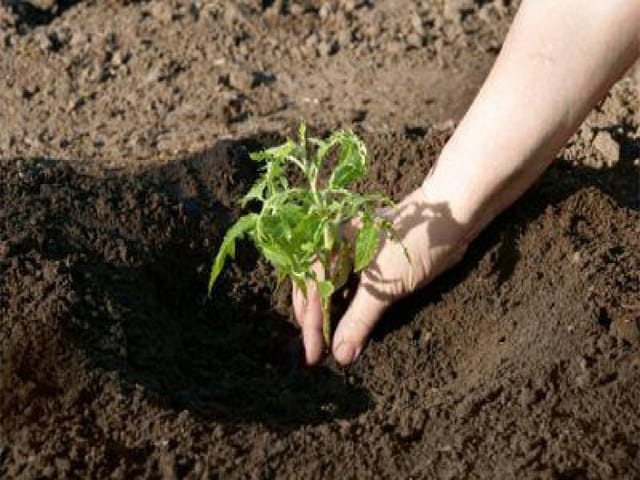

Tips for saving bushes from the cold
Severe Russian frosts can adversely affect the health and attractive appearance of an Asian plant. Therefore, for the winter, he needs to cut all the greens to the very root. In addition to protecting against death, this measure will also update the structure of the bush, so that next year it will be even more magnificent and beautiful.
If the depth of the layer of the fallen snow is small, the trimmed bushes must be additionally covered with handy materials. It can be humus or peat. Mown grass with agrofibre will also be a good option; if these recommendations are followed, winter hardiness will increase.
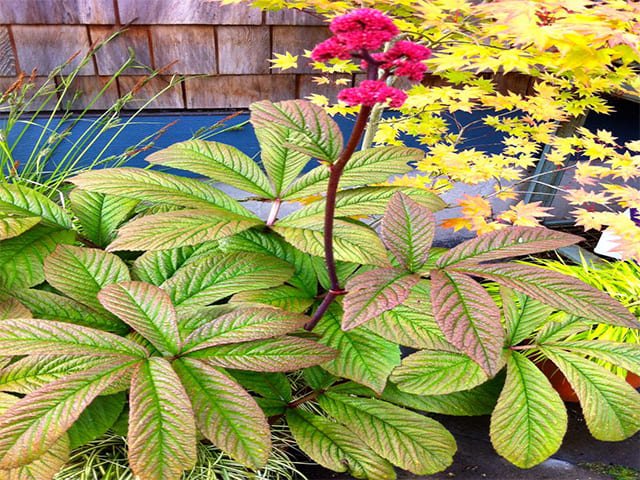

Garden decoration
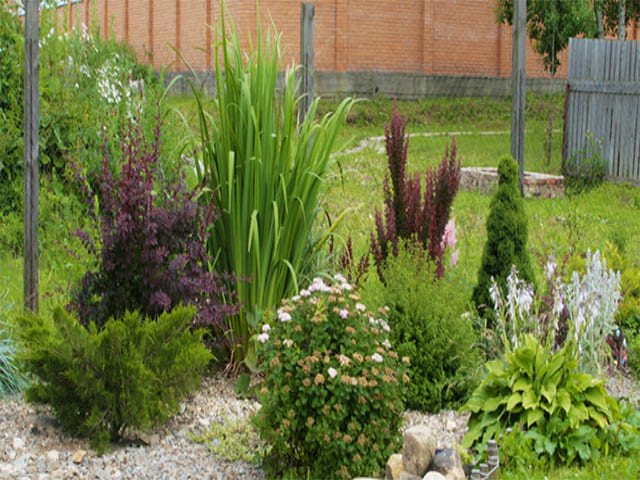

Rogersia is loved by many florists for its ability to effectively fit into any garden interior. It is perfect as a decoration for flower beds, flower beds, borders. An ideal place for an Asian beauty is a rocky garden.
Also looks luxurious in combination with other ornamental plants. The interlacing of large leaves of Rogersia and Fern in combination with Tiarella or Hosta will be a great element of the landscaping of the garden plot. Duets of several different varieties also look very presentable.
When drawing up flower arrangements, it is necessary to take into account that these bushes, due to their high height, can shade some light-loving crops. The plant will be in perfect harmony with conifers and bushes. Juniper or Cypress will be a great match for him.
Useful Tips


- When planting, the roots are buried in the soil no more than 60 mm.
- You can mulch the soil with straw or sunflower husks.
- Falling flowers and foliage may be associated with too little watering. Adjust the watering mode.
- In dry hot periods, the bushes are regularly watered, and also moistened with a sprayer (by the evening, the drops on the foliage should dry out).
- Sprinkle the surface of the soil around the bushes with crushed egg shells or wood ash to prevent slugs from reaching them.
Varieties of culture
In the genus of this plant, there are over 8 varieties of crops. They grow mainly in the countries named above. Rogersia has a large type of foliage and white flowers, collected in a beautiful inflorescence. This culture will dominate any flower garden and attract attention with its beauty and originality.
| View | Description | Photo |
| Rogersia Elderberry | Grows in China in pine forests. During the flowering period, the classic plant size is 120 cm in height. The foliage is feathery, similar in shape to the leaves of an elder. Inflorescences are represented by small creamy panicles. Flowering begins in July. |
|
| Horse chestnut rogers | Naturally grows in the Chinese mountains. During flowering, the height of the plant reaches 140 cm or more. The blossoming leaves are bronze in color. |
|
| Feathery rogers | In the process of flowering, the plants reach a length of 1.2 m. The leaves have strong petioles. When foliage blooms, it turns purple in color, and subsequently takes on a dark green hue. The stem is branched, and the inflorescences are represented by a panicle with white flowers. | |
| Rogers podophyllum | In the natural environment, it can grow in China, Japan, Korea.Such a culture has no distinctive features, except that it is endowed with an impressive number of embossed veins. When blooming, the leaves turn bronze and then green. |
|
In addition to these species, there are several more interspecific hybrid varieties that also have their own characteristics.

